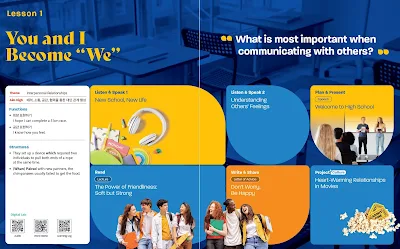Lesson 1 You and I Become "We"
The Power of Friendliness: Soft but Strong
It’s good to see you, everyone!
I’m Dr. Edward Wilson, an evolutionary biologist.
Thank you for inviting me here today.
On my way, I had trouble locating this room.
Luckily, a friendly student came up to me and walked me here.
It’s fascinating how, in situations like this, we want to help someone in need.
Now, this raises some interesting questions:
where does our friendliness come from, and why is it important?
To answer these questions, I’d like to tell you about my childhood companion dog, Sparky.
When we played with a ball, I noticed that he responded well to my gestures.
The responsive behavior of dogs also caught the attention of an evolutionary anthropologist, Brian Hare.
He conducted an experiment to see how dogs would respond to human gestures compared to wolves, who share the same common ancestor.
He placed two cups on the ground with food hidden under only one of them.
When he pointed to the cup with the food, the dogs found it easily.
The wolves, however, struggled and chose cups at random, paying no attention to his gestures.
Dr. Hare concluded that the dogs’ ability to read human gestures allowed them to perform better than the wolves.
He explained that dogs, unlike wolves, have developed communicative skills with humans and a sense of friendliness.
This explanation sounds reasonable according to several evolutionary biologists.
They say that from the common ancestors of these two species,
those that acted friendly toward humans evolved into dogs,
and those that didn’t became wolves.
Furthermore, Dr. Hare suggested that the friendly nature of dogs probably provided them a survival advantage that allowed their population to grow larger than that of wolves.
I’ll give you another example of how friendliness is related to survival.
Dr. Hare and his colleagues designed an experiment with chimpanzees and bonobos.
Although the two are genetically similar, they are different in nature.
To study their cooperative behavior, Dr. Hare’s team set up a device which required two individuals to pull both ends of a rope at the same time in order to access food on a board.
When placed with partners that the chimpanzees knew, they were able to work together to get the food.
However, when paired with new partners, the chimpanzees usually failed to get the food, and when they occasionally succeeded, they did not share the food with their partner.
The bonobos, on the other hand, got along much better than the chimpanzees.
They solved the problem regardless of which individual they were paired with, and they were also more willing to share the food.
This research shows that bonobos have a cooperative and friendly nature.
Experts suggest that their nature has helped their species survive.
Without these characteristics, they could have faced extinction.
Now let’s turn our attention to ourselves, Homo sapiens.
How have we managed to survive for so long?
Neanderthals existed together with Homo sapiens until about 40,000 years ago,
and they were known to be intelligent and physically superior to Homo sapiens.
Neanderthals were able to make tools and f ire and had strong bodies with well-developed muscles and broad shoulders.
Despite these attributes, however, it was Homo sapiens who ultimately survived and thrived.
One possible explanation is that our ancestors lived in larger communities that promoted cooperation and the free exchange of knowledge,
while Neanderthals tended to live in smaller groups.
These social differences may have given Homo sapiens a competitive advantage over Neanderthals, allowing them to adapt to an ever-changing environment.
In our competitive society, many people believe that only the biggest or the strongest can survive and thrive.
However, I propose an alternative view: kindness is the key to success.
Isn’t that a comforting thought?
We can use the power of our natural kindness to communicate and cooperate with different individuals.
We can all benefit from this instead of trying to be better than others.
I’d like to end this talk with a message.
Think of our society as a bouquet.
Just as each flower adds to the beauty when it harmonizes with the others,
each person can contribute to a more beautiful world when they cooperate.
By being kind and working together, we can truly flourish.
Thank you for your attention.
1과 본문 전체 듣기
1과 본문 pdf 다운받기

